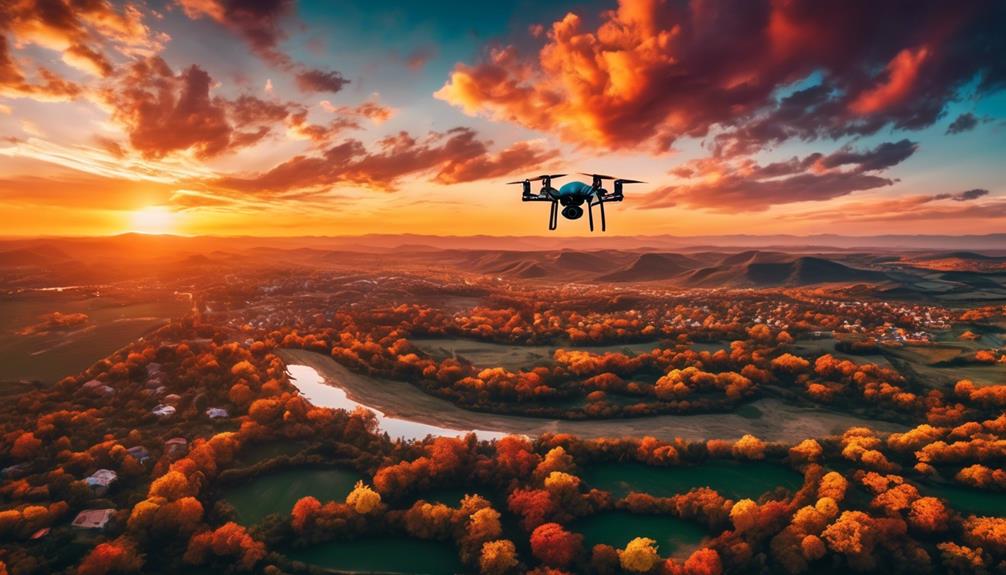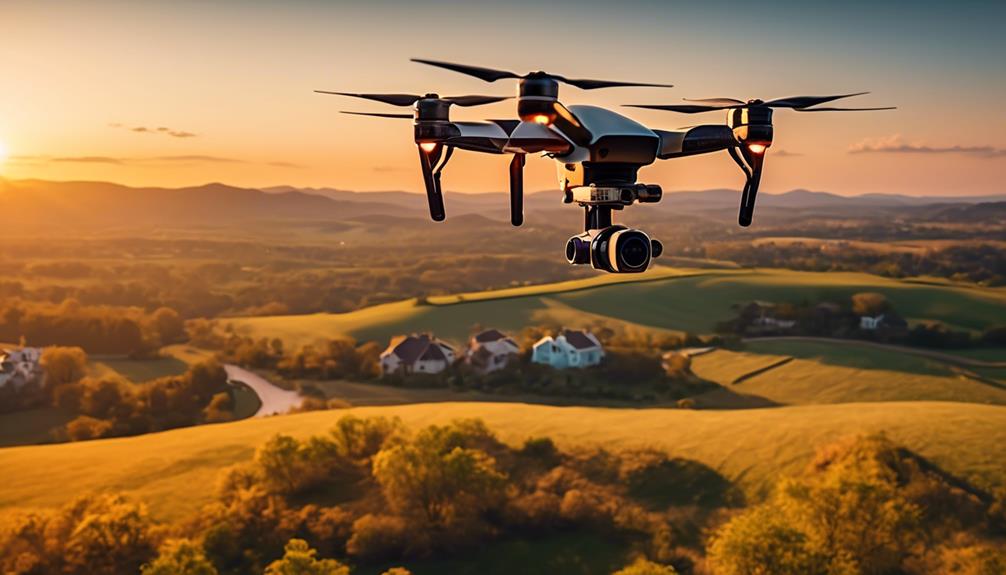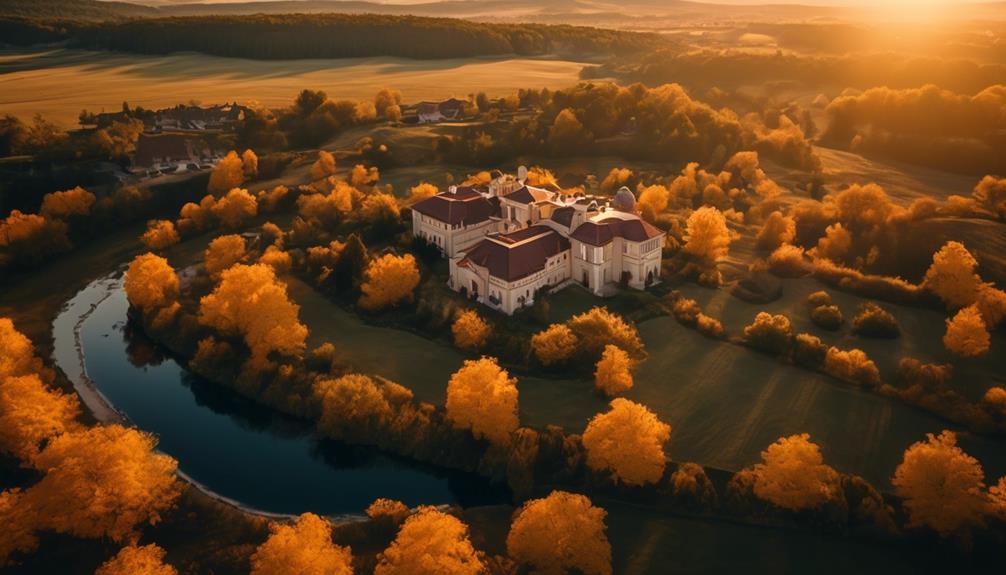Please note this post may contain affiliate links picked by me (Jay) that I have deemed may be of interest or relevant to you the reader of this.
These links do not affect the cost of the thing if you decide to purchase but i may get a little money if you choose to purchase.
For more information on my affiliate link policy click here.
As I soared high above the breathtaking landscape, I couldn't help but marvel at the stunning photographs I was able to capture with my drone.
Little did I know that mastering the art of drone photography required more than just pressing the shutter button. It took me hours of trial and error to discover the top 7 drone photography settings that would transform my amateur shots into professional-grade masterpieces.
From ISO settings to focus options, join me on this journey as I unveil the secrets to achieving jaw-dropping aerial imagery that will leave you in awe.
Key Takeaways
- Understanding exposure settings (ISO, shutter speed, aperture, white balance) is crucial for achieving desired results in drone photography.
- Metering techniques, such as evaluative metering and spot metering, can help optimize exposure in different shooting situations.
- Familiarizing oneself with focus options like autofocus, manual focus, focus peaking, and continuous autofocus can greatly improve the sharpness and clarity of drone photographs.
- Exploring different shooting modes, such as auto mode, manual mode, panorama mode, burst mode, and point of interest mode, allows for creativity and versatility in capturing unique aerial images.
ISO Settings for Drone Photography
When it comes to capturing stunning aerial shots with your drone, mastering the ISO settings is key. These settings can greatly enhance your nighttime photography and help you achieve the perfect exposure. ISO, which stands for International Standards Organization, is a measure of how sensitive your camera's sensor is to light. In simpler terms, it determines how bright or dark your images will be.
To get the best results in nighttime photography, you need to understand how ISO works. The higher the ISO value, the more sensitive your camera becomes to light. This means you can capture images in low light conditions without using a long exposure time, which can result in blurry photos. However, increasing the ISO also introduces more digital noise or grain to your images. It's all about finding the right balance.
Another important setting to consider is exposure compensation. This allows you to adjust the exposure level of your images, making them brighter or darker. When shooting at night, you might find that your drone's automatic settings don't always capture the scene as you want it. By using exposure compensation, you can take control and fine-tune the exposure to achieve the desired effect.
Innovation in drone photography isn't just about capturing stunning shots, but also about experimenting with different settings to push the boundaries of what's possible. By mastering the ISO settings and understanding exposure compensation, you can take your nighttime aerial photography to new heights.
Shutter Speed Adjustments for Aerial Shots
To capture breathtaking aerial shots with your drone, mastering the art of adjusting shutter speed is essential. It's like having the power to freeze time or create beautiful motion blur in your photos. So, let's dive into the world of shutter speed adjustments for aerial shots and unlock the secrets to stunning drone photography.
When it comes to exposure compensation tips for aerial photography, understanding shutter speed is crucial. The shutter speed determines the amount of time the camera's sensor is exposed to light. A fast shutter speed, such as 1/1000th of a second, freezes motion and captures sharp details. On the other hand, a slow shutter speed, like 1/30th of a second, allows for more light to enter the sensor, resulting in a longer exposure and potential motion blur.
But achieving motion blur in aerial shots can be tricky. That's where ND filters come in handy. ND filters, or neutral density filters, reduce the amount of light entering the camera without affecting the color balance. By using ND filters, you can use slower shutter speeds even in bright conditions, which is essential for capturing that dreamy motion blur in your aerial shots.
When choosing ND filters for your drone, consider the conditions you'll be shooting in. For example, if you're shooting on a sunny day, a higher ND filter like ND16 or ND32 can help achieve the desired motion blur effect. On overcast days, a lower ND filter like ND4 or ND8 might be sufficient.
Aperture Control for Capturing Stunning Landscapes
Now that we've mastered the art of adjusting shutter speed for capturing stunning aerial shots, let's turn our attention to the next important aspect of drone photography: aperture control for capturing stunning landscapes. Aperture refers to the size of the opening in the lens through which light enters the camera. By understanding how to control the aperture, you can create beautiful depth of field effects and ensure the perfect exposure for your landscape shots.
One important technique to consider is using a wide aperture (low f-stop) to create a shallow depth of field. This means that your subject will be sharp and in focus, while the background will be blurred, adding a sense of depth and dimension to your images. On the other hand, using a narrow aperture (high f-stop) will result in a greater depth of field, keeping both the subject and the background in focus. This can be useful when you want to capture the entire landscape in sharp detail.
To make things easier, here are some exposure compensation tips for different lighting conditions:
| Lighting Condition | Exposure Compensation |
|---|---|
| Bright sunlight | -1/3 to -2/3 EV |
| Overcast skies | +1/3 to +2/3 EV |
| Backlit scenes | +1 to +2 EV |
White Balance Settings for Vibrant Colors
Adjusting the white balance settings is a key factor in achieving vibrant and true-to-life colors in your drone photography. The white balance setting determines the overall color temperature of your images, and getting it right can make a huge difference in the final result.
So, here are four essential tips to help you master white balance settings and bring out the most vibrant colors in your drone photos:
- Understand Color Temperature Adjustment: Color temperature refers to the warmth or coolness of light. Different lighting conditions have different color temperatures, and adjusting the white balance allows you to compensate for these variations. For example, if you're shooting during sunset, you may want to increase the warmth to capture the beautiful golden hues of the sky.
- Experiment with Preset Modes: Most drones offer preset white balance modes such as Auto, Sunny, Cloudy, and Tungsten. These modes are designed to match the color temperature of specific lighting conditions. Don't be afraid to try them out and see which one works best for your desired effect.
- Shoot in RAW: Shooting in RAW format gives you more flexibility in post-processing. When it comes to white balance, this means you can easily adjust and fine-tune the color temperature during the editing process. RAW files preserve more image data, allowing for more accurate color grading techniques.
- Use a Grey Card: A grey card is a simple yet powerful tool for achieving accurate white balance. It provides a neutral reference point for the camera to calibrate colors correctly. Just hold the grey card in front of your camera before shooting, and then use it as a reference when adjusting the white balance in post-processing.
Metering Modes for Balanced Exposures
When it comes to capturing perfectly balanced exposures in your drone photography, understanding and utilizing the various metering modes is essential. Metering modes are tools that help your drone's camera determine the correct exposure settings based on the available light.
Two commonly used metering modes are evaluative metering and spot metering.
Evaluative metering, also known as matrix metering, is the default setting on most drones. It divides the frame into multiple zones and analyzes each zone for optimal exposure. This mode is great for capturing scenes with a wide range of light, such as landscapes. It ensures that both the bright sky and the darker ground are well exposed. With evaluative metering, you can trust that your drone will make the right decisions to achieve balanced exposures.
On the other hand, spot metering allows you to pinpoint a specific area in the frame and base the exposure solely on that spot. This mode is useful when you want to expose for a particular subject or when there's a significant difference in lighting between the subject and the background. By using spot metering, you can ensure that your subject is properly exposed, even if the rest of the frame is overexposed or underexposed.
Both evaluative metering and spot metering have their advantages, and the choice between the two depends on the specific shooting situation. Experiment with both modes to see which one works best for you and the creative vision you want to achieve.
Focus Options for Sharp and Clear Images
To capture sharp and clear images in your drone photography, understanding and utilizing the various focus options is crucial. In this article, I'll walk you through the different focus techniques that will elevate your drone photography game. So, let's dive in!
Here are four focus options that will help you achieve sharp and clear images:
- Depth of field techniques for creative compositions: By adjusting the aperture settings on your drone camera, you can control the depth of field. A shallow depth of field creates a blurred background, highlighting the subject in sharp focus. On the other hand, a deep depth of field keeps everything in the frame sharp and clear.
- Autofocus vs. manual focus for precise image control: Most drone cameras come with autofocus capabilities, which automatically adjust the focus based on the subject. However, in certain situations where you want precise control over the focus, switching to manual focus can be beneficial. This is especially useful when capturing landscapes or architectural details.
- Focus peaking for enhanced clarity: Some drone cameras offer a feature called focus peaking, which helps you identify the areas in focus by highlighting them with colored lines or dots. This feature is particularly handy when shooting in challenging lighting conditions or when you're unsure if the subject is in focus.
- Continuous autofocus for moving subjects: When capturing fast-moving subjects, such as cars or wildlife, using continuous autofocus can ensure that your images remain sharp. This feature tracks the subject and adjusts the focus accordingly, allowing you to capture dynamic and action-packed shots.
Shooting Modes for Different Scenarios
In order to capture stunning shots in a variety of scenarios, understanding the different shooting modes available on your drone camera is essential. These modes allow you to adapt to different environments and capture the perfect shot every time. Let's dive into some of the most useful shooting modes for different scenarios.
Firstly, there's the Auto mode, which is great for beginners. It takes care of all the settings for you, allowing you to focus on framing the perfect shot. However, if you want more control, try the Manual mode. This mode allows you to adjust the exposure, shutter speed, and ISO to your liking.
If you're shooting landscapes, the Panorama mode is a must-try. It automatically captures multiple photos and stitches them together to create a stunning wide-angle image. This mode is perfect for capturing vast landscapes and cityscapes.
For action shots, the Burst mode is your best friend. It captures a rapid series of shots, ensuring that you don't miss a single moment. This mode is great for capturing fast-moving subjects like sports events or wildlife.
When it comes to composition techniques for capturing unique perspectives, the Point of Interest mode is a game-changer. It allows you to select a specific point in your frame, and the drone will automatically orbit around it, giving you a dynamic and eye-catching shot.
Once you've captured your shots, it's time for post-processing. To enhance your drone photos, consider adjusting the exposure, contrast, and saturation. You can also experiment with different filters to add a creative touch to your images.
With these shooting modes and post-processing tips, you'll be well-equipped to capture stunning drone photos in any scenario. So go out there, unleash your creativity, and capture the world from a whole new perspective!
Frequently Asked Questions
What Type of Drones Are Recommended for Aerial Photography?
When it comes to aerial photography, finding the best drone for beginners is key.
There are a few factors to consider when choosing one. First, look for a drone with a high-resolution camera to capture stunning images.
Next, make sure it has a stable flight system for smooth shots.
Lastly, consider the drone's battery life and range to ensure you can capture those epic shots.
With the right drone, your aerial photography skills will soar to new heights!
How Can I Ensure My Drone Captures Sharp and Clear Images?
When it comes to drone photography, capturing sharp and clear images is crucial.
To ensure the best results, I've discovered some handy techniques and camera settings.
First, make sure your drone is stable and steady before taking shots.
Adjusting the shutter speed and aperture can also enhance image quality.
Additionally, using the right ISO and white balance settings will help you achieve stunning aerial photographs.
Are There Any Specific Safety Guidelines or Regulations I Should Be Aware of When Using Drones for Photography?
When it comes to drone photography, there are definitely some safety guidelines and regulations you should be aware of.
It's important to fly your drone in a responsible manner and abide by any local laws or restrictions. Some common guidelines include keeping your drone within line of sight, avoiding crowded areas, and respecting people's privacy.
Additionally, make sure to check for any specific drone photography regulations in your area. Safety should always be a top priority when using drones for photography.
Can I Adjust the Camera Settings While the Drone Is in Flight?
Sure, you can absolutely adjust the camera settings while the drone is in flight. It's like being a wizard with a magic wand, except instead of casting spells, you're capturing stunning aerial shots.
So, whether you want to tweak the exposure, adjust the white balance, or play around with the shutter speed, go ahead and experiment mid-flight. Just make sure to follow the recommended camera settings for drone photography to achieve jaw-dropping results.
Happy flying and snapping!
What Are Some Common Challenges or Issues That Beginners Face When Starting With Drone Photography?
Starting out with drone photography can be challenging for beginners. Common mistakes include not understanding the different camera settings, struggling with composition and framing, and dealing with unpredictable weather conditions.
But fear not! I've got some tips and tricks to help you navigate these issues.
By familiarizing yourself with your drone's settings, practicing composition techniques, and keeping an eye on the weather, you'll be well on your way to capturing stunning aerial shots in no time.
Conclusion
So there you have it, the top 7 drone photography settings for newbies. Remember to play around with these settings and experiment to find the perfect combination for your shots.
And here's an interesting statistic to keep in mind: Did you know that drone photography has become so popular that there are currently over 1.7 million drones registered with the Federal Aviation Administration in the United States alone?
So get out there and start capturing stunning aerial images with your drone!


